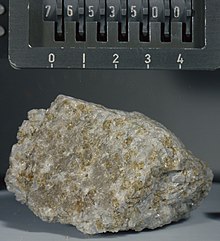Troctolite
Troctolite (also troctolite or trout stone) is a rock from the group of mafic plutonites .
Rock description and mineral inventory
The mineral inventory includes plagioclase ( labradorite and bytownite ), olivine , up to 5% pyroxene and, in small amounts, biotite , hornblende , magnetite and sulfidic ore minerals, but never quartz . With this composition, troctolites belong to the group of gabbroids , but instead of pyroxenes they contain significantly more olivine. Troctolites are often medium to coarse-grained and have a characteristic spotted appearance, which is caused by the dark green olivines in a light plagioclase matrix. Because of its dotted appearance, the stone was given the name trout stone by stonemasons .
Origin and occurrence

Similar to gabbros, troctolites occur as components of oceanic crust and are also found in collision orogens as a result of autopsy . They also occur in the continental crust in stratified intrusions along with other gabbroids and ultramafic rocks. Examples are the Bushveld Complex in South Africa or the Stillwater Complex in Montana . In Germany, troctolites are found in the Harz Mountains as part of the Harzburg gabbro.
Troctolites have also been found on the moon .
literature
- Walter Maresch & Olaf Medenbach: Rocks . Mosaik-Verlag, Munich 1996, ISBN 3-576-10699-5 , pp. 62-63 .
- Wolfhard Wimmenauer : Petrography of igneous rocks . Enke, Stuttgart 1985, ISBN 3-432-94671-6 , pp. 97-105 .
